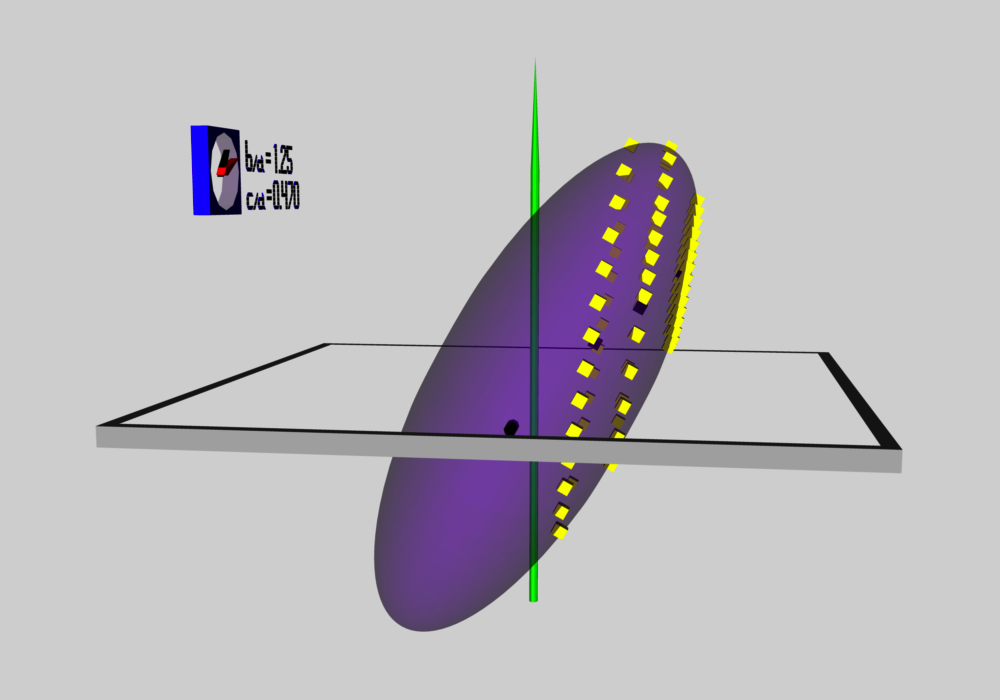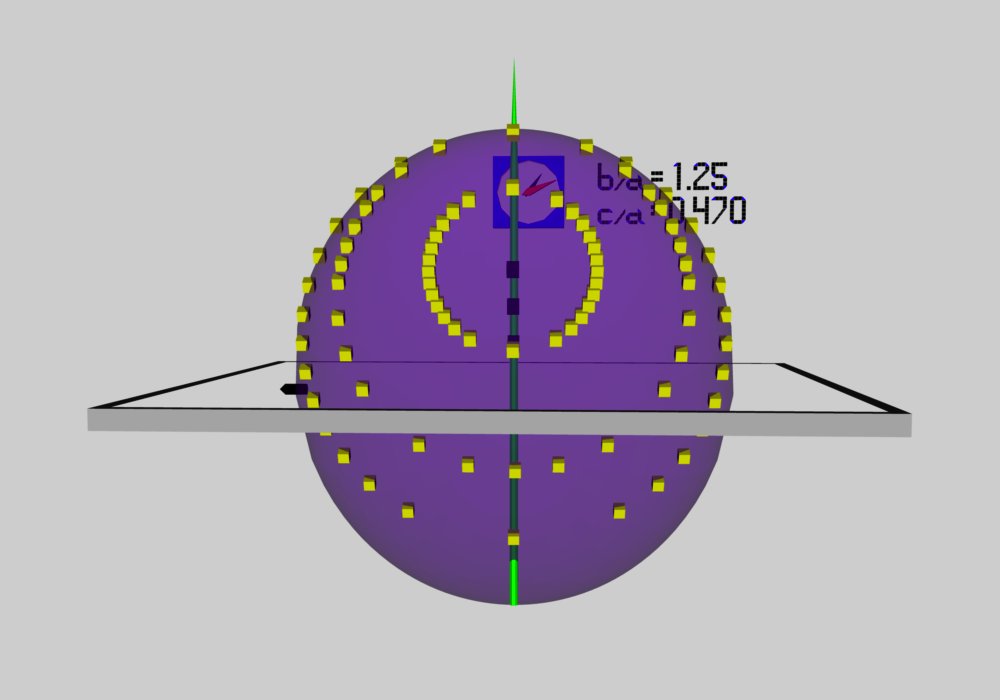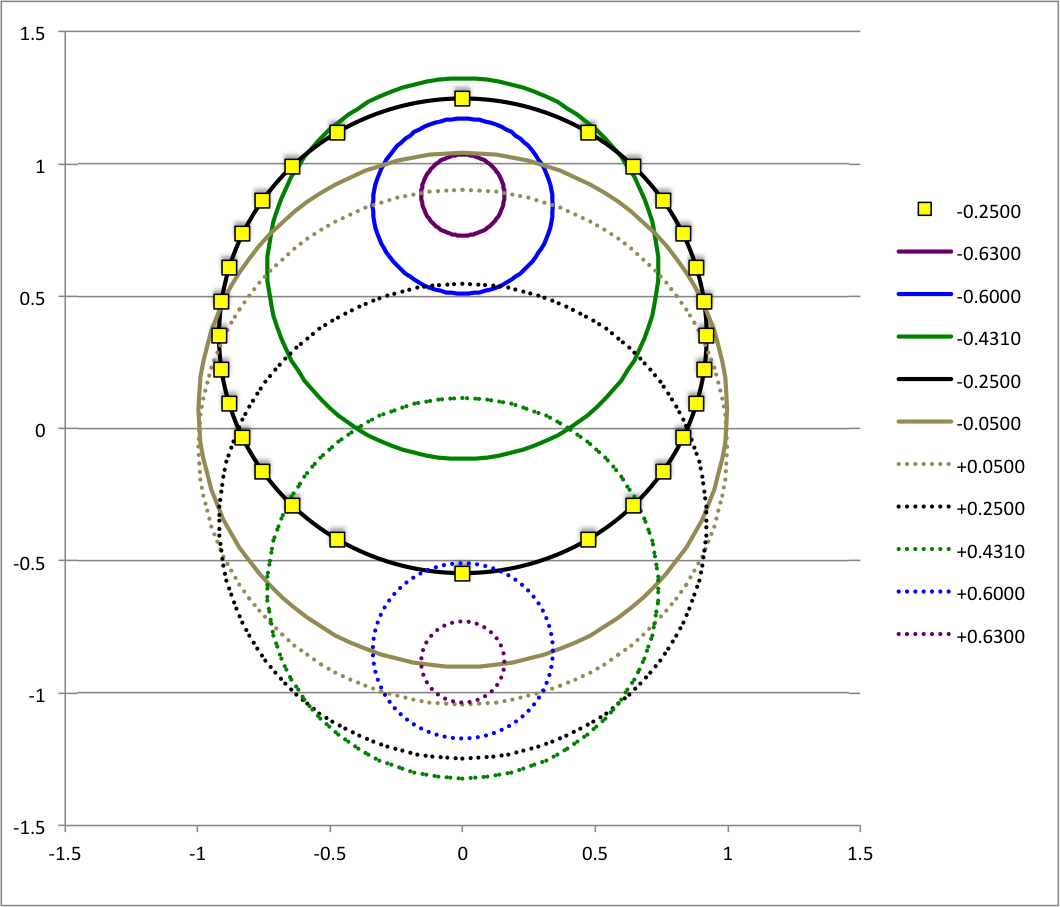User:Tohline/ThreeDimensionalConfigurations/ChallengesPt2
Challenges Constructing Ellipsoidal-Like Configurations (Pt. 2)
This chapter extends an accompanying chapter titled, Construction Challenges (Pt. 1). The focus here is on an SCF technique that will incorporate specification of a Lagrangian flow-flied.

|
|---|
| | Tiled Menu | Tables of Content | Banner Video | Tohline Home Page | |
Motivation
In a separate discussion, we have shown that, as viewed from a frame that "tumbles" with the (purple) body of a Type 1 Riemann ellipsoid, each Lagrangian fluid element moves along an elliptical path in a plane that is tipped by an angle <math>~\theta</math> about the x-axis of the body. (See the yellow-dotted orbits in Figure panels 1a and 1b below). As viewed from the (primed) coordinates associated with this tipped plane, by definition, z' = 0 and dz'/dt = 0, and the planar orbit is defined by the expression for an,
| Off-Center Ellipse | ||
|
<math>~1</math> |
<math>~=</math> |
<math>~\biggl(\frac{x'}{x_\mathrm{max}} \biggr)^2 + \biggl(\frac{y' - y_0}{y_\mathrm{max}} \biggr)^2 \, .</math> |
As a function of time, the x'-y' coordinates and associated velocity components of each Lagrangian fluid element are given by the expressions,
|
<math>~x'</math> |
<math>~=</math> |
<math>~x_\mathrm{max}\cos(\dot\varphi t)</math> |
and, |
<math>~y' - y_0</math> |
<math>~=</math> |
<math>~y_\mathrm{max}\sin(\dot\varphi t) \, ,</math> |
|
<math>~\dot{x}'</math> |
<math>~=</math> |
<math>~- x_\mathrm{max}~ \dot\varphi \cdot \sin(\dot\varphi t)</math> |
and, |
<math>~\dot{y}' </math> |
<math>~=</math> |
<math>~y_\mathrm{max}~\dot\varphi \cdot \cos(\dot\varphi t) \, .</math> |
Here we provide analytic expressions for these various quantities — <math>~x_\mathrm{max}, y_\mathrm{max}, y_0, \dot\varphi</math> — in terms of the properties of any chosen Type 1 Riemann ellipsoid.
Intersection of Tipped Plane With Ellipsoid Surface
Body Frame
In a an early subsection of the accompanying discussion, we have pointed out that the intersection of each Lagrangian fluid element's tipped orbital plane with the surface of the (purple) ellipsoidal surface is given by the (unprimed) body-frame coordinates that simultaneously satisfy the expressions,
|
<math>~1</math> |
<math>~=</math> |
<math>~\biggl( \frac{x}{a}\biggr)^2 + \biggl( \frac{y}{b}\biggr)^2 + \biggl( \frac{z}{c}\biggr)^2 </math> |
and, |
<math>~z</math> |
<math>~=</math> |
<math>~y \tan\theta + z_0 \, ,</math> |
where z0 is the location where the tipped plane intersects the z-axis of the body frame. Combining these two expressions, we see that an intersection between the tipped plane and the ellipsoidal surface will occur at (x, y)-coordinate pairs that satisfy what we will henceforth refer to as the,
| Intersection Expression | ||
|
<math>~1 - \frac{x^2}{a^2} </math> |
<math>~=</math> |
<math>~\frac{y^2}{b^2} + \biggl[ \frac{y\tan\theta + z_0}{c}\biggr]^2 </math> |
|
|
<math>~=</math> |
<math>~y^2 \biggl[\frac{c^2 + b^2\tan^2\theta}{b^2c^2} \biggr] + y \biggl[ \frac{2z_0 \tan\theta}{c^2} \biggr] + \frac{z_0^2}{c^2} \, , </math> |
as long as z0 lies within the range,
|
<math>~z_0^2</math> |
<math>~\le</math> |
<math>~c^2 + b^2\tan^2\theta \, .</math> |
Tipped Orbital Plane
A table provided in our accompanying discussion shows how to transform from the body-frame coordinates (unprimed) to the (primed) frame that aligns with the Lagrangian fluid element's orbit. Specifically,
|
Using the 2nd and 3rd of these relations, we see from the equation that defines the "tipped plane," that,
|
<math>~z_0 + z' \cos\theta + y'\sin\theta</math> |
<math>~=</math> |
<math>~[ y' \cos\theta - z'\sin\theta ]\tan\theta + z_0</math> |
|
<math>~\Rightarrow ~~~z' \biggl[ \cos\theta + \tan\theta \cdot \sin\theta \biggr]</math> |
<math>~=</math> |
<math>~y' [ \cos\theta \cdot \tan\theta - \sin\theta] </math> |
|
<math>~\Rightarrow ~~~\frac{z'}{\cos\theta} </math> |
<math>~=</math> |
<math>~0</math> |
|
<math>~\Rightarrow ~~~z' </math> |
<math>~=</math> |
<math>~0 \, .</math> |
Hence, as viewed from the primed coordinate frame, all points of intersection between the tipped plane and the surface of the ellipsoid will be found in the <math>~z' = 0</math> plane, as desired. Inserting the 1st and 2nd of these relations into the above-defined Intersection Expression, we find,
|
<math>~1 - \frac{(x')^2}{a^2} </math> |
<math>~=</math> |
<math>~\biggl[ y' \cos\theta - \cancelto{0}{z'} \sin\theta \biggr]^2 \biggl[\frac{c^2 + b^2\tan^2\theta}{b^2c^2} \biggr] + \biggl[ y' \cos\theta - \cancelto{0}{z'} \sin\theta \biggr] \biggl[ \frac{2z_0 \tan\theta}{c^2} \biggr] + \frac{z_0^2}{c^2}</math> |
|
|
<math>~=</math> |
<math>~(y')^2\biggl[\frac{c^2 \cos^2\theta + b^2\sin^2\theta}{b^2c^2} \biggr] - 2(y')\biggl[ - \frac{z_0 \sin\theta}{c^2} \biggr] + \frac{z_0^2}{c^2} \, .</math> |
Off-Center Ellipse
Now we attempt to transform this last expression into the form of the above-defined equation for an Off-Center Ellipse, which we rewrite here as,
|
<math>~1 - \frac{(x')^2}{x^2_\mathrm{max}} </math> |
<math>~=</math> |
<math>~\frac{1}{y^2_\mathrm{max}}\biggl[ (y')^2 - 2(y')y_0 + y_0^2 \biggr] \, .</math> |
An initial rearrangement of the relevant "last" expression gives,
|
<math>~1 - \frac{z_0^2}{c^2} - \frac{(x')^2}{a^2} </math> |
<math>~=</math> |
<math>~ \frac{c^2 \cos^2\theta + b^2\sin^2\theta}{b^2c^2} \biggl[(y')^2 - 2(y') \underbrace{ \biggl( - \frac{z_0 b^2 \sin\theta}{c^2 \cos^2\theta + b^2\sin^2\theta}\biggr) }_{y_0} \biggr] \, ,</math> |
which, as indicated, allows us to identify the appropriate expression for the y-offset, <math>~y_0</math>. Dividing through by the leading coefficient,
<math>~\kappa^2 \equiv \frac{c^2 \cos^2\theta + b^2\sin^2\theta}{b^2c^2} \, ,</math>
then adding <math>~y_0^2</math> to both sides gives,
|
<math>~ (y')^2 - 2(y') y_0 + y_0^2 </math> |
<math>~=</math> |
<math>~ \frac{1}{\kappa^2}\biggl[ 1 - \frac{z_0^2}{c^2} - \frac{(x')^2}{a^2} \biggr] + y_0^2 </math> |
|
|
<math>~=</math> |
<math>~ \underbrace{\biggl[ \frac{1}{\kappa^2} - \frac{z_0^2}{c^2\kappa^2} + y_0^2 \biggr]}_{y^2_\mathrm{max}} - \frac{(x')^2}{\kappa^2 a^2} \, , </math> |
which gives us the appropriate expression for <math>~y_\mathrm{max}^2</math>. Finally, dividing through by <math>~y_\mathrm{max}^2</math> gives,
|
<math>~ \frac{1}{y_\mathrm{max}^2} \biggl[ (y')^2 - 2(y') y_0 + y_0^2 \biggr] </math> |
<math>~=</math> |
<math>~ 1 - (x')^2 \underbrace{ \biggl[ \frac{1}{y_\mathrm{max}^2 \kappa^2 a^2} \biggr]}_{1/x^2_\mathrm{max}} \, , </math> |
which identifies the appropriate expression for <math>~x^2_\mathrm{max}</math>. As viewed from the "tipped plane" (primed) coordinate frame, then, the equation for the orbit of each Lagrangian fluid element is that of an …
with,
| |||||||||||||||||||||||||||
Velocities
Tipped Orbit Velocities
From the generic expressions for (primed) velocities associated with an off-center elliptical orbit, we expect,
|
<math>~\frac{\dot{x}'}{\dot\varphi}</math> |
<math>~=</math> |
<math>~ -x_\mathrm{max} \sin(\dot\varphi t) = - (y' - y_0) \biggl[ \frac{x_\mathrm{max}}{y_\mathrm{max}} \biggr] \, , </math> and, |
|
<math>~\frac{\dot{y}'}{\dot\varphi}</math> |
<math>~=</math> |
<math>~ y_\mathrm{max} \cos(\dot\varphi t) = x' \biggl[ \frac{y_\mathrm{max}}{x_\mathrm{max}} \biggr] \, . </math> |
Body Frame Velocities
From the already-referenced table provided in our accompanying discussion, we can transform this pair of expressions for the velocity components in the "tipped orbit" frame — remember that the third component, <math>~\dot{z}' = 0</math> — into the (three-component) velocities of the body frame using the expressions,
|
|
That is to say,
|
<math>~\frac{\dot{x}}{\dot\varphi}</math> |
<math>~=</math> |
<math>~ - (y' - y_0) \biggl[ \frac{x_\mathrm{max}}{y_\mathrm{max}} \biggr] = \biggl[ \frac{x_\mathrm{max}}{y_\mathrm{max}} \biggr] \biggl\{ y_0 - [y\cos\theta + (z-z_0)\sin\theta] \biggr\} \, , </math> |
|
<math>~\frac{\dot{y}}{\dot\varphi}</math> |
<math>~=</math> |
<math>~ x' \biggl[ \frac{x_\mathrm{max}}{y_\mathrm{max}} \biggr] \cos\theta = x \biggl[ \frac{x_\mathrm{max}}{y_\mathrm{max}} \biggr] \cos\theta \, , </math> |
|
<math>~\frac{\dot{z}}{\dot\varphi}</math> |
<math>~=</math> |
<math>~ x' \biggl[ \frac{x_\mathrm{max}}{y_\mathrm{max}} \biggr] \sin\theta = x \biggl[ \frac{x_\mathrm{max}}{y_\mathrm{max}} \biggr] \sin\theta \, , </math> |
where,
|
<math>~\biggl[\frac{x_\mathrm{max}}{y_\mathrm{max}} \biggr]^2</math> |
<math>~=</math> |
<math>~ \frac{a^2}{b^2 c^2}\biggl[ c^2 \cos^2\theta + b^2\sin^2\theta \biggr] \, . </math> |
Notice that the all-important tipping angle, <math>~\theta</math>, is related to these body-frame velocity components via the simple relation,
|
<math>~\tan\theta</math> |
<math>~=</math> |
<math>~\biggl( \frac{\dot{z}}{\dot{y}} \biggr) \, .</math> |
Riemann-Derived Velocity Components
We have summarized in an accompanying discussion
First, we acknowledge that EFE provides an expression for the velocity vector of each fluid element, given its instantaneous body-coordinate position (x, y, z) = (x1, x2, x3). Namely — see eq. 154 of Chapter 7, §51 (p. 156) —
|
<math>~u_1</math> |
<math>~=</math> |
<math>~- \biggl[ \frac{a^2}{a^2 + b^2} \biggr] \zeta_3 y + \biggl[ \frac{a^2}{a^2 + c^2} \biggr] \zeta_2 z</math> |
<math>~=</math> |
<math>~+\biggl[ \frac{a^2}{ b^2} \biggr]\Omega_3 \gamma y - \biggl[ \frac{a^2}{c^2} \biggr] \Omega_2 \beta z \, ,</math> |
|
<math>~u_2</math> |
<math>~=</math> |
<math>~+\biggl[ \frac{b^2}{a^2 + b^2} \biggr] \zeta_3 x</math> |
<math>~=</math> |
<math>~- \Omega_3 \gamma x \, ,</math> |
|
<math>~u_3</math> |
<math>~=</math> |
<math>~- \biggl[ \frac{c^2}{a^2 + c^2} \biggr] \zeta_2 x</math> |
<math>~=</math> |
<math>~-\Omega_2 \beta x \, .</math> |
Example Equilibrium Model
These key parameters have been drawn from [EFE] Chapter 7, Table XIII (p. 170):
| <math>~a = a_1 = 1</math> |
| <math>~b = a_2 = 1.25</math> |
| <math>~c = a_3 = 0.4703</math> |
| <math>~\Omega_2 = 0.3639</math> |
| <math>~\Omega_3 = 0.6633</math> |
| <math>~\zeta_2 = - 2.2794</math> |
| <math>~\zeta_3 = - 1.9637</math> |
As a consequence — see an accompanying discussion for details — the values of other parameters are …
| Example Values | ||||||
|
<math>~\tan\theta </math> |
<math>~=</math> |
<math>~- \frac{\zeta_2 }{ \zeta_3 } \biggl[ \frac{a^2 + b^2}{a^2 + c^2} \biggr]\frac{c^2}{b^2} = -0.344793</math> |
<math>~~ \theta =</math> |
<math>~- 19.0238^\circ</math> |
||
|
<math>~ \Lambda </math> |
<math>~\equiv</math> |
<math> \biggl[ \frac{a^2}{a^2 + b^2} \biggr] \zeta_3 \cos\theta - \biggl[ \frac{a^2}{a^2 + c^2} \biggr] \zeta_2 \sin\theta </math> |
<math>~\Lambda =</math> |
<math>~-1.332892 </math> |
||
|
<math>~ \frac{y_0}{z_0} </math> |
<math>~=</math> |
<math> \biggl[ \frac{a^2}{a^2 + c^2} \biggr] \frac{\zeta_2}{\Lambda} </math> |
<math>~\frac{y_0}{z_0} =</math> |
<math>~+ 1.400377</math> |
||
|
<math>~ \frac{x_\mathrm{max}}{ y_\mathrm{max} } </math> |
<math>~=</math> |
<math>~ \biggl\{ \Lambda \biggl[ \frac{a^2 + b^2}{b^2} \biggr] \frac{\cos\theta}{\zeta_3} \biggr\}^{1 / 2} </math> |
<math>~\frac{x_\mathrm{max}}{y_\mathrm{max}} =</math> |
<math>~+ 1.025854</math> |
||
|
<math>~ \varphi </math> |
<math>~=</math> |
<math>~ \biggl\{ \Lambda \biggl[ \frac{b^2}{a^2 + b^2} \biggr] \frac{\zeta_3 }{\cos\theta} \biggr\}^{1 / 2} </math> |
<math>~\varphi =</math> |
<math>~+1.299300</math> |
||
COLLADA-Based Representation
As has been described in an accompanying discussion of Riemann Type 1 ellipsoids, we have used COLLADA to construct an animated and interactive 3D scene that displays in purple the surface of an example Type I ellipsoid; panels a and b of Figure 1 show what this ellipsoid looks like when viewed from two different perspectives. (As a reminder — see the explanation accompanying Figure 2 of that accompanying discussion — the ellipsoid is tilted about the x-coordinate axis at an angle of 61.25° to the equilibrium spin axis, which is shown in green.) Yellow markers also have been placed in this 3D scene at each of the coordinate locations specified in the table that accompanies that discussion. From the perspective presented in Figure 3b, we can immediately identify three separate, nearly circular trajectories; the largest one corresponds to our choice of z0 = -0.25, the smallest corresponds to our choice of z0 = -0.60, and the one of intermediate size correspond to our choice of z0 = -0.4310. When viewed from the perspective presented in Figure 1a, we see that these three trajectories define three separate planes; each plane is tipped at an angle of θ = -19.02° to the untilted equatorial, x-y plane of the purple ellipsoid.
See Also

|
|---|
|
© 2014 - 2021 by Joel E. Tohline |


